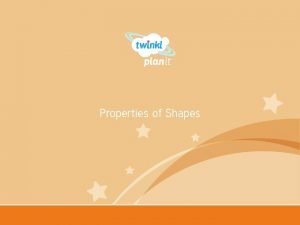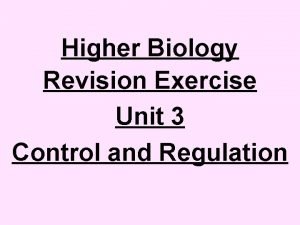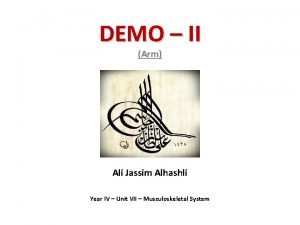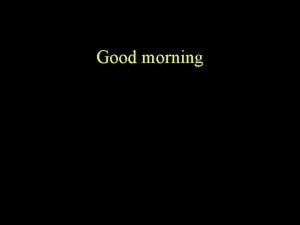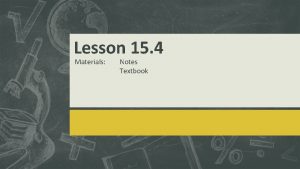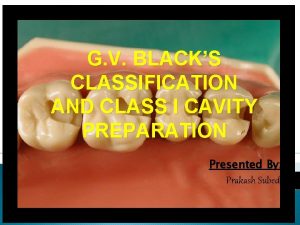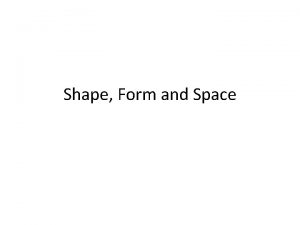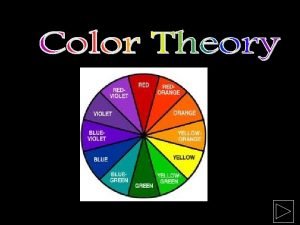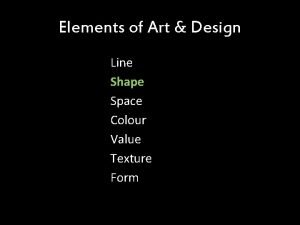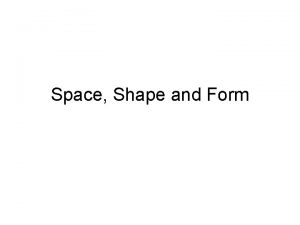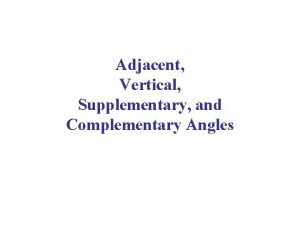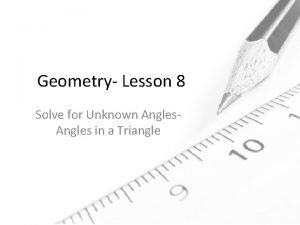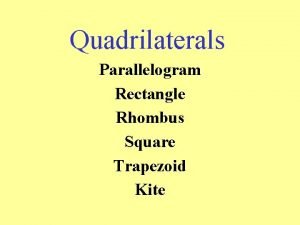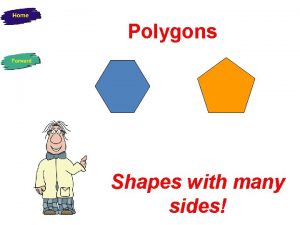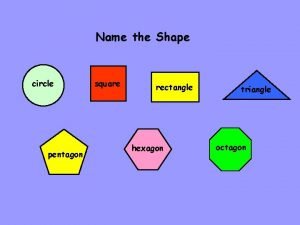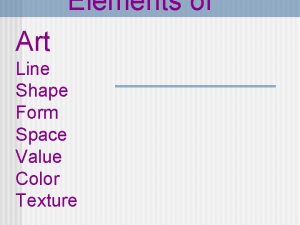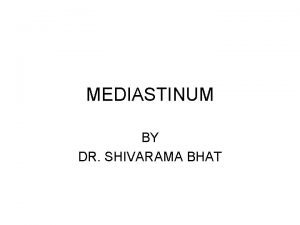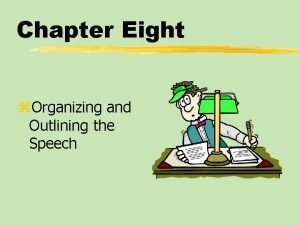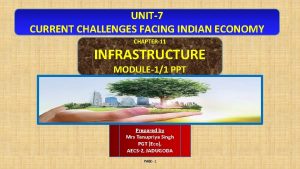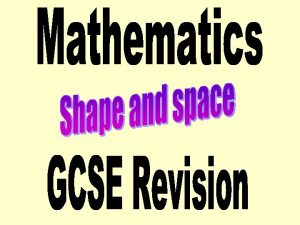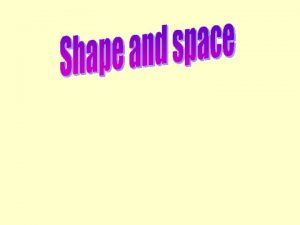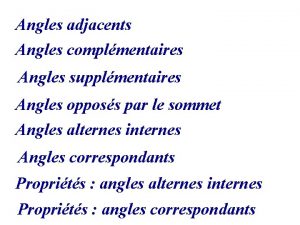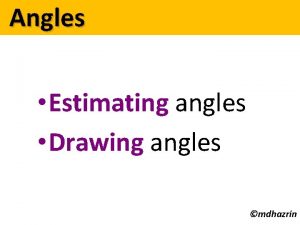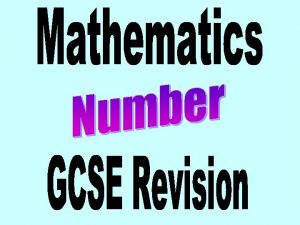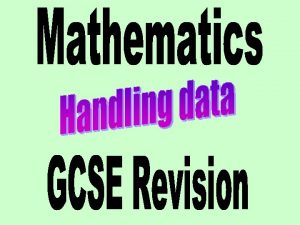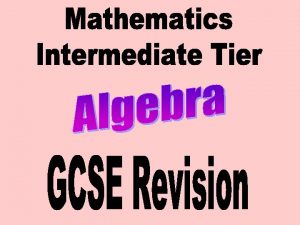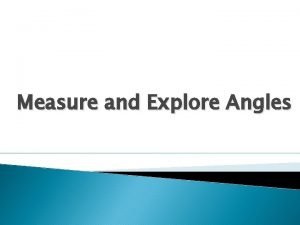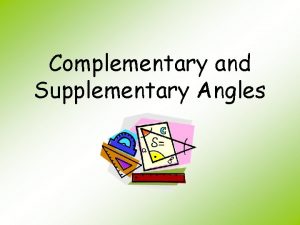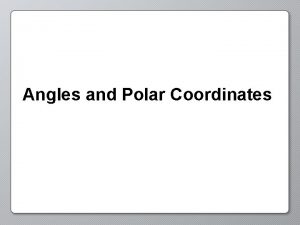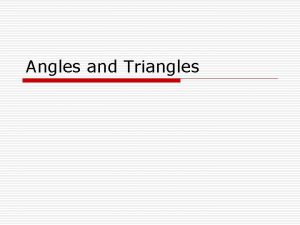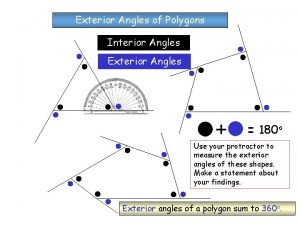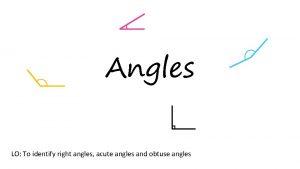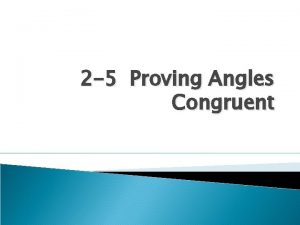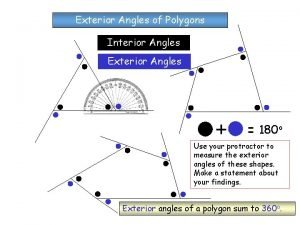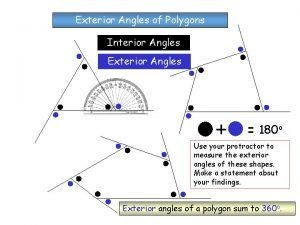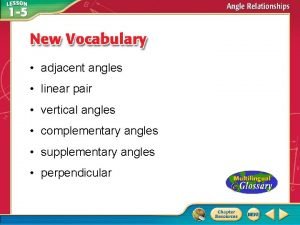Higher Tier Shape and space revision Contents Angles









































- Slides: 41


Higher Tier – Shape and space revision Contents : Angles and polygons Area and arc length of circles Area of triangle Volume and SA of solids Spotting P, A & V formulae Transformations Constructions Loci Similarity Congruence Pythagoras Theorem SOHCAHTOA 3 D Pythag and Trig of angles over 900 Sine rule Cosine rule Circle angle theorems Vectors

Angles and polygons Angles at = the centre 360 No. of sides c c c There are 3 types of angles in regular polygons Exterior = 360 angles No. of sides Interior = 180 - e angles e e e i e Calculate the value of c, e and i in regular polygons with 8, 9, 10 and 12 sides Answers: 8 sides = 450, 1350 9 sides = 400, 1400 10 sides = 360, 1440 12 sides = 300, 1500 To calculate the total interior angles of an irregular polygon divide it up into triangles from 1 corner. Then no. of x 180 Total i = 5 x 180 = 9000

Area 1. What would you do to get the area of each of these shapes? Do them step by step! 1. 5 m 3. 2. 4 m 2 m 9 m 10 cm 2 26. 5 cm 2 5∏cm 2 7 m 2 m 8 m 6 m 4. 5. 2 30. 9 cm 6 m 3 m 19. 9 cm 2 6 m 1. 5 m

Area of triangle There is an alternative to the most common area of a triangle formula A = (b x h)/2 and it’s to be used when there are 2 sides and the included angle available. First you need to know how to label a triangle. Use capitals for angles and lower case letters for the sides opposite to them. C a B Area = ½ ab sin C b A c The included angle = 180 – 67 – 54 = 590 7 cm 6. 3 cm Area = ½ ab sin C Area = 0. 5 x 6. 3 x 7 x sin 59 Area = 18. 9 cm 2 670 540

Area and arc lengths of circles Circle Area = x r 2 Circumference = x D Sector Area = x x r 2 360 Arc length = x x D 360 540 4. 8 cm Area sector = 54/360 x 3. 14 x 4. 8 = 10. 85184 cm 2 Area triangle = 0. 5 x 4. 8 x sin 54 = 9. 31988 cm 2 Area segment = 10. 85184 – 9. 31988 = 1. 54 cm 2 Arc length = 54/360 x 3. 14 x 9. 6 = 4. 52 cm Segment Area = Area of sector – area of triangle

Volume and surface area of solids 1. Calculate the volume and surface area of a cylinder with a height of 5 cm and a diameter at the end of 6 cm 5 Volume = x r 2 x h = 3. 14 x 3 x 5 = 141. 3 cm 3 r 2 D 5 6 Surface area = r 2 + ( D x h) = x 32 + ( x 6 x 5) = 56. 52 + 90. 2 = 150. 72 cm 2 r 2 The formulae for spheres, pyramids (where used) and cones are given in the exam. However, you need to learn how to calculate the volume and surface area of a cylinder

Volume and surface area of solids 2. Calculate the volume and surface area of a cone with a height of 7 cm and a diameter at the end of 8 cm Volume = 1/3 ( x r 2 x h) = 1/3 (3. 14 x 4 x 7) = 117. 2 cm 3 7 8 L r 2 Slant height (L) = (72 + 42) = 65 = 8. 06 cm Curved surface area = r L Total surface area = r L + r 2 = (3. 14 x 8. 06) + (3. 14 x 4) = 101. 2336 + 50. 24 = 151. 47 cm 2

Volume and surface area of solids 3. Calculate the volume and surface area of a sphere with a diameter of 10 cm. 5 Volume = 4/3 ( x r 3 ) = 4/3 (3. 14 x 5 x 5) = 523. 3 cm 3 Curved surface area = 4 r 2 = 4 x 3. 14 x 5 = 314 cm 2 Watch out for questions where the surface area or volume have been given and you are working backwards to find the radius.

Spotting P, A & V formulae P Which of the following expressions could be for: (a) Perimeter (b) Area (c) Volume 4 r 2 3 4 l 2 h V 1 r 3 P 4 rl r(r + l) 4 r + ½r 1 rh 3 A 4 r 3 3 A P V 1 r 2 h 3 r + 4 l V P V A A 1 d 2 A 4 r 2 h r( + 3) 3 lh 2 V rl A

Transfromations 1. Reflection y Reflect the triangle using the line: y=x then the line: y=-x then the line: x=1 x

Describe the rotation of A to B and C to D y 2. Rotation B When describing a rotation always state these 3 things: • No. of degrees • Direction • Centre of rotation e. g. a rotation of 900 anticlockwise using a centre of (0, 1) C x A D Transfromations

What happens when we translate a shape ? The shape remains the same size and shape and the same way up – it just……. slides. Transfromations 3. Translation Horizontal translation Use a vector to describe a translation Vertical translation Give the vector for the translation from……. . D 6 0 1. A to B 2. A to D 3. B to C 4. D to C -3 -1 C 6 5 -3 4 A B 3 -4

Transfromations y 4. Enlargement Enlarge this shape by a scale factor of 2 using centre O Now enlarge the original shape by a scale factor of - 1 using centre O x O

Constructions Have a look at these constructions and work out what has been done 900 Perpendicular bisector of a line Triangle with 3 side lengths Bisector of an angle 600

Loci A locus is a drawing of all the points which satisfy a rule or a set of constraints. Loci is just the plural of locus. A goat is tethered to a peg in the ground at point A using a rope 1. 5 m long 1. Draw the locus to show all that grass he can eat A 1. 5 m A goat is tethered to a rail AB using a rope (with a loop on) 1. 5 m long 2. Draw the locus to show all that grass he can eat 1. 5 m A B 1. 5 m

Similarity Shapes are congruent if they are exactly the same shape and exactly the same size Shapes are similar if they are exactly the same shape but different sizes How can I spot similar triangles ? These two triangles are similar because of the parallel lines Triangle C Triangle B Triangle A All of these “internal” triangles are similar to the big triangle because of the parallel lines

Triangle 2 Similarity These two triangles are similar. Calculate length y y = 17. 85 2. 1 = 8. 5 m Same multiplier x 2. 1 y Triangle 1 17. 85 m 7. 2 m x 2. 1 Multiplier = 15. 12 7. 2 = 2. 1 15. 12 m

These two cylinders are similar. Calculate length L and Area A. Similarity in 2 D & 3 D Don’t fall into the trap of thinking that the scale factor can be found by dividing one area by another area Write down all these equations immediately: 6. 2 x scale factor = L A x scale factor 2 = 156 214 x scale factor 3 = 3343. 75/214 scale factor 3 = 15. 625 scale factor = 2. 5 So 6. 2 x 2. 5 = L and A x 2. 52 = 156 L = 15. 5 cm A = 24. 96 cm 2 156 cm 2 L A 6. 2 cm Volume = 3343. 75 cm 3 Volume = 214 cm 3

Shapes are congruent if they Congruence are exactly the same shape and exactly the same size There are 4 conditions under which 2 triangles are congruent: SSS - All 3 sides are the same in each triangle 18 m 13 m 10 m 13 m 18 m SAS - 2 sides and the included angle are the same in each triangle 11 cm 710 9 cm 710 11 cm

ASA - 2 angles and the included side are the same in each triangle 520 11 cm 520 360 11 cm Be prepared to justify RHS - The right angle, hypotenuse and another side are the same in these congruence rules each triangle by PROVING that they work 12 m 5 m 5 m 12 m

Pythagoras Theorem Calculating the Hypotenuse D How to spot a Be prepared to leave your answer Pythagoras in surd form (most likely in the question 21 cm ? Hyp 2 = a 2 + b 2 DE 2 = 212 + 452 DE 2 = 441 + 2025 DE 2 = 2466 non-calculator exam) DE = 2466 F 45 cm Right angled 2 = a 2 + b. E 2 Hyp DE = 49. 659 D Calculate 2 the size triangle DE = 49. 7 cm DE = 32 + 62 ? 3 cm of DE to 12 d. p. DE = 9 + 36 2 = 45 DE Hyp 2 = a 2 + b 2 No angles Calculating a shorter side 162 = AC 2 + 112 DE = 45 involved 6 cm E A in question. F DE = 9 x 5 256 = AC 2 + 121 Calculate the size m DE = 3 5 cm 256 - 121 = AC 2 of DE in surd form 11 How to spot the 135 = AC 2 Hypotenuse 135 = AC 16 m B C 11. 618 = AC Longest side & Calculate the size opposite AC = 11. 6 m of AC to 1 d. p. ?

Pythagoras Questions Look out for the following Pythagoras questions in disguise: Finding lengths in isosceles triangles Find the distance x between 2 co-ords y x x Finding lengths inside a circle 1 (angle in a semi -circle = 900) O O Finding lengths inside a circle 2 (radius x 2 = isosc triangle)

SOHCAHTOA Calculating an angle D O F Right angled triangle An angle involved in question H 26 cm How to spot a Trigonometry question E A 53 cm =26. 10 Calculate the size of to 1 d. p. Calculating a side SOHCAHTOA Sin = O/H Sin 73 = 11/H D O 1 m • Label sides H, O, A • Write SOHCAHTOA • Write out correct rule • Substitute values in • If calculating angle use 2 nd func. key SOHCAHTOA Tan = O/A Tan = 26/53 Tan = 0. 491 ? 1 A 730 B H Calculate the size of BC to 1 d. p. C H = 11/Sin 73 H = 11. 5 m

3 D Pythag and Trig Always work out a strategy first Calculate the height of a square-based pyramid Find base diagonal 1 st 1 a Calculate the length of the longest 2 a diagonal inside a cylinder 20 cm 12 cm Calculate the angle this diagonal makes with the vertical 12 cm SOHCAHTOA Tan = 12/20 Tan = 0. 6 20 cm = 30. 960 1 b D 2 = 5 2 + 5 2 D 2 = 50 D = 7. 07 11 m D/2 5 m 2 b 5 m 112 = H 2 + 3. 5352 121 = H 2 + 12. 5 H 2 = 121 – 12. 5 H = 10. 4 m Calculate the angle between a sloping face and the base 10. 4 m Hyp 2 = 202 + 122 Hyp 2 = 400 + 144 Hyp 2 = 544 Hyp = 23. 3 cm 2. 5 m SOHCAHTOA Tan = 10. 4/2. 5 Tan = 4. 16 = 76. 480

Trig of angles > 900 – The Sine Curve We can use this graph to find all the angles (from 0 to 360) which satisfy the equation: Sin = 0. 64 First angle is found on your calculator INV, Sin, 0. 64 = 39. 80. You then use the symmetry of the graph to find any others. Sine 1 = 39. 80 and 140. 20 0. 64 39. 8 -1 900 ? 1800 ? = 180 – 39. 8 = 140. 20 2700 3600

Trig of angles > 900 – The Cosine Curve We can use this graph to find all the angles (from 0 to 360) which satisfy the equation: Cos = - 0. 2 Use your calculator for the 1 st angle INV, Cos, - 0. 2 = 101. 50 You then use the symmetry of the graph to find any others. Cosine 1 ? = 270 – 11. 5 = 258. 50 = 101. 50 and 258. 50 101. 5 0. 2 -1 900 ? 1800 2700 3600

Trig of angles > 900 – The Tangent Curve We can use this graph to find all the angles (from 0 to 360) which satisfy the equation: Tan = 4. 1 Use your calculator for the 1 st angle INV, Tan, 4. 1 = 76. 30 You then use the symmetry of the graph to find any others. Tangent 10 4. 1 1 -1 -10 76. 3 900 1800 ? = 180 + 76. 3 = 256. 30 ? 2700 3600 = 76. 30 and 256. 30

Sine rule If there are two angles involved in the question it’s a Sine rule question. Use this version of the rule to find angles: Sin A = Sin B = Sin C a b c e. g. 1 A b C a 620 7 m B Use this version of the rule to find sides: a = b = c . Sin A Sin B Sin C c 23 m Sin A = Sin B = Sin C a b c Sin = Sin B = Sin 62 7 b 23 Sin = Sin 62 x 7 23 Sin = 0. 2687 = 15. 60 e. g. 2 C b 520 a 8 m B a = b = c . Sin A Sin B Sin C 8 = b = ? . Sin 9 Sin B Sin 52 ? = 8 x Sin 52 Sin 9 ? = 40. 3 m 90 ? c A

If there is only one angle involved (and all 3 sides) it’s a Cosine rule question. Cosine rule Use this version of the rule to find sides: a 2 = b 2 + c 2 – 2 bc Cos A Use this version of the rule to find angles: Cos A = b 2 + c 2 – a 2 2 bc C e. g. 1 2. 3 m c ? a 32 cm b B 670 A 45 cm c Always label the one angle involved - A B a 2 = b 2 + c 2 – 2 bc Cos A a 2 = 322 + 452 – 2 x 32 x 45 x Cos 67 a 2 = 3049 – 1125. 3 a = 43. 86 cm A e. g. 2 2. 1 m b 3. 4 m a Cos A = b 2 + c 2 – a 2 2 bc Cos = 2. 12 + 2. 32 – 3. 42 2 x 2. 1 x 2. 3 Cos = - 1. 86 9. 66 = 101. 10 C

How to tackle Higher Tier trigonometry questions Triangle in the question ? Have you just got side lengths in the question ? Yes Yes No Use SOHCAHTOA Use the Pythagoras rule Hyp 2 = a 2 + b 2 Is it right angled ? No No Use this Sine rule if you are finding a side a = b = c Sin A Sin B Sin C Use this Sine rule if you are finding an angle Sin A = Sin B = Sin C a b c Are all 3 side lengths involved in the question ? Yes Use this Cosine rule if you are finding a side a 2 = b 2 + c 2 – 2 bc. Cos. A Label “a” as the side to be calculated Use this Cosine rule if you are finding an angle Cos. A = b 2 + c 2 – a 2 2 bc Label “A” as the angle to be calculated

Extra tips for trig questions Redraw triangles if they are cluttered with information or they are in a 3 D diagram Right angled triangles can be easily found in squares, rectangles and isosceles triangles Remember to use the Shift Button when calculating an angle The ambiguous case only occurs for sine rule questions when you are given the following information Angle Side in that order (ASS) which should be easy to remember

Circle angle theorems Rule 1 - Any angle in a semi-circle is 900 A F Which angles are equal to 900 ? c E B C D

Circle angle theorems Rule 2 - Angles in the same segment are equal Which angles are equal here? Big fish ? *!

Rule 3 - The angle at the centre is twice the angle at the circumference Circle angle theorems c c c An arrowhead A little fish c c Three radii A mini quadrilateral Look out for the angle at the centre being part of a isosceles triangle

Circle angle theorems Rule 4 - Opposite angles in a cyclic quadrilateral add up to 1800 D A C B A + C = 1800 and B + D = 1800

Circle angle theorems Rule 5 - The angle between the tangent and the radius is 900 c A tangent is a line which rests on the outside of the circle and touches it at one point only

Circle angle theorems Rule 6 - The angle between the tangent and chord is equal to any angle in the alternate segment Which angles are equal here?

Circle angle theorems Rule 7 - Tangents from an external point are equal (this might create an isosceles triangle or kite) Be prepared to justify these circle theorems by PROVING that c they work

Vectors Think of a vector as a “journey” from one place to another. A vector represents a “movement” and it has both magnitude (size) and direction Y c d L X H A vector is shown as a line with an arrow on it It can be labelled in two ways: Using a lower case bold letter (usually a or b – this is the vector’s size) Or using the starting point’s letter followed by the destination point’s letter with an arrow on top (e. g. GF – this shows the direction). Find in terms of c and d, the vectors XY, YX, HL, LH, LY, YL, HX, XH, HY, LX XY = c YX = - c HL = c LY = d HX = d HY = c + d LH = - c YL = - d XH = - d LX = d – c

S Vectors T P Q R If PS = a , PR = b , Q cuts the line PR in the ratio 2: 1 and T cuts the line PS in the ratio 1: 3, find the value of : (a) PT (b) SR (c) PQ (d) QT (e) QS (a) PT = ¼ PS so PT = ¼ a (c) PQ = 2/3 PR so PQ = 2/3 b (e) QS =QR + RS so QS = 1/3 b – (– a + b) Remember SR = (d) QT = QP + PT so QT = - a + b- aso QS = -2/3 b + a (b) SR = SP + PR so SR = +b - 2/3 b + ¼ a
 Tier 1 tier 2 tier 3 vocabulary
Tier 1 tier 2 tier 3 vocabulary Tier 3 words
Tier 3 words Vertically opposite angles
Vertically opposite angles Passive progressive
Passive progressive The chemical that promotes phototropism is _____.
The chemical that promotes phototropism is _____. Bbc bitesize higher pe command words
Bbc bitesize higher pe command words Subscapular artery anastomosis
Subscapular artery anastomosis Triangular space contents
Triangular space contents Suprasternal space of burns contents
Suprasternal space of burns contents Module 15 lesson 1 central angles and inscribed angles
Module 15 lesson 1 central angles and inscribed angles G.v. black's classification
G.v. black's classification Triangle with no equal sides
Triangle with no equal sides Shape matching and object recognition using shape contexts
Shape matching and object recognition using shape contexts Bolongie
Bolongie What is shape
What is shape Form shape and space
Form shape and space Art line color
Art line color Color, form, line, shape, space, texture, and value.
Color, form, line, shape, space, texture, and value. Form shape and space
Form shape and space Are adjacent angles complementary
Are adjacent angles complementary Find the unknown labeled angles
Find the unknown labeled angles Square rectangle rhombus trapezoid
Square rectangle rhombus trapezoid Pentagon how many sides
Pentagon how many sides Shape that has 5 sides
Shape that has 5 sides Aerofoil shapes
Aerofoil shapes Polygon drawings line color value texture shape space form
Polygon drawings line color value texture shape space form Line shape form color texture space
Line shape form color texture space Cartesian space trajectory planning
Cartesian space trajectory planning Space junk the space age began
Space junk the space age began Camera space to world space
Camera space to world space Unscented trajectory chapter 5
Unscented trajectory chapter 5 World space to screen space
World space to screen space N tier architecture advantages and disadvantages
N tier architecture advantages and disadvantages Cause and effect contents of the dead man's pocket
Cause and effect contents of the dead man's pocket Middle mediastinum
Middle mediastinum Outlining and organizing the speech contents
Outlining and organizing the speech contents Elagse
Elagse 3 tier web application architecture
3 tier web application architecture Three tier system of health infrastructure
Three tier system of health infrastructure Tier 2 advanced power strip
Tier 2 advanced power strip Maria tier 0
Maria tier 0 Tier 1 interventions examples
Tier 1 interventions examples


